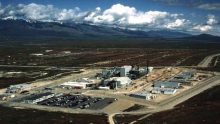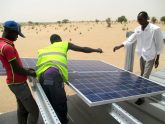An improved forecasting of weather changes can reduce the Levelized Cost of Electricity (LCOE) for solar-diesel hybrid microgrids by optimizing the investment costs for storage and improving the operations of the diesel gensets and storage systems
Balancing the intermittencies in remote PV-diesel hybrid applications presents one of the most convincing business cases for energy storage. In the simplest case without storage, if clouds shade the PV array, then the load of the gensets is increased in order to provide the needed power. As traditional gensets can hardly be run below a minimum load of 30-40%, and have a ramp-up time of several minutes without storage, then gensets typically cannot be switched off as they need to provide spinning reserve for sudden solar irradiation changes.
The integration of storage allows for these gaps to be bridged while operating the gensets. This means that on sunny days the diesel gensets might be switched off and the share of PV in the microgrid can be increased accordingly. As power from diesel gensets is very expensive, especially in remote locations due to transport costs, the business case for solar plus storage is much better than for many grid-connected applications. If power drops caused by shading of the PV array can be forecasted precisely, then diesel gensets can be switched off during sunny days without using storage systems. The microgrid has to be conceived in a way that the solar plant forms the grid. STEADYSUN has developed a sky imager called SteadyEye, which takes hemispherical photos of the sky every minute. A proprietary forecasting algorithm calculates the possible impact of clouds on the PV production.
The influence is two-tier in regard to a possible integration of storage in solar-diesel hybrid systems, particularly in applications where shading occurs extremely rarely and where it is likely that sky imagers will crowd out storage solutions. More common will be the cases where sky imagers will be complementary and so optimize storage solutions. Forecasting weather patterns permits a parameterization of the microgrid that optimizes the number of generator starts and the use of the storage system. For example, if unsteady conditions are forecasted then we need to consider whether diesel gensets should actually be shut down and restarted frequently which has a negative influence on both, gensets and storage systems. A tailor-made solution can then take into consideration specific conditions on the generation side as well on the consumption side. In certain parameterizations, the risk of production losses can be driven down to virtually zero; for other systems with low consequences, such as stopping an air-condition system for a few minutes, this can be accepted in order to increase diesel reductions.
“Sky imagers add significant value to basically every PV-diesel hybrid system. The associated costs are extremely moderate,” explains Xavier Le Pivert, CEO of STEADYSUN. “Our innovative solution has been proved in several insular grid and off-grid applications. It can optimize investment costs and operating costs at the same time.”
Weather forecasting with sky imagers reduces investment and O&M costs in solar-diesel hybrid systems. This is another step toward more mature decentralized power generation. Software simulation tools that include sky imagers are also being developed. They support functions for dimensioning and designing the optimal mode of operation of a hybrid system based on various framework conditions, such as different needs in regard to a secure supply of energy, electricity costs and various load and irradiation patterns.
Beyond their application in off-grid solar-diesel hybrid systems, similar advantages are inherent to small insular microgrids with solar power, rural electrification in weak grid areas and smart grids in an urban environment where a network of sky imagers can be deployed.
The corresponding white paper can be downloaded at: http://www.th-energy.net/english/platform-renewable-energy-and-mining/reports-and-white-papers/
About THEnergy (Dr. Thomas Hillig Energy Consulting)
THEnergy is consultancy that assists technology providers such as STEADYSUN to enter commercial and industrial markets such as mining or tourism. Onsite power generation incl. renewable energy and energy storage is one of the main consulting focusses. In addition, THEnergy structures onsite power generation projects and connects the necessary stakeholders.




